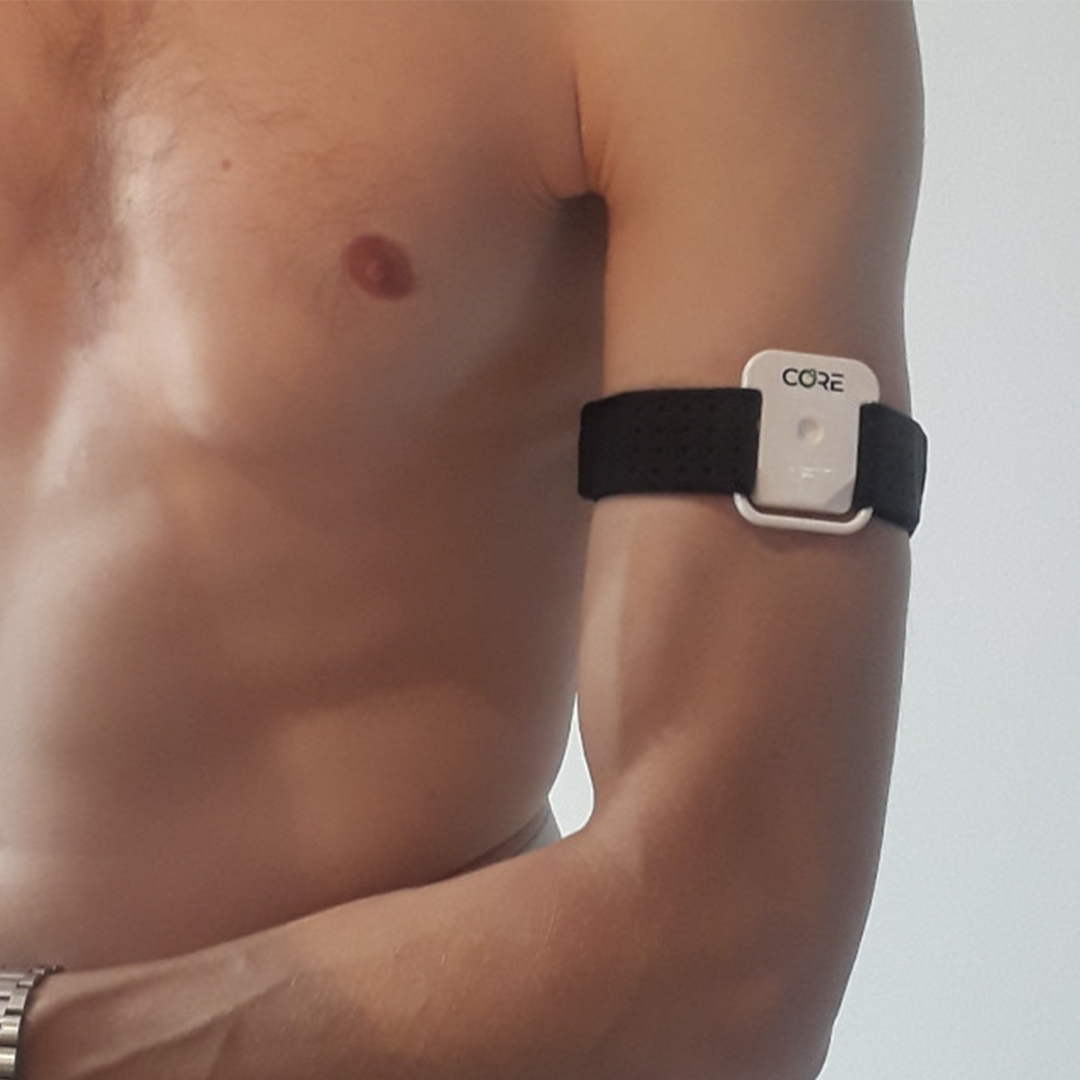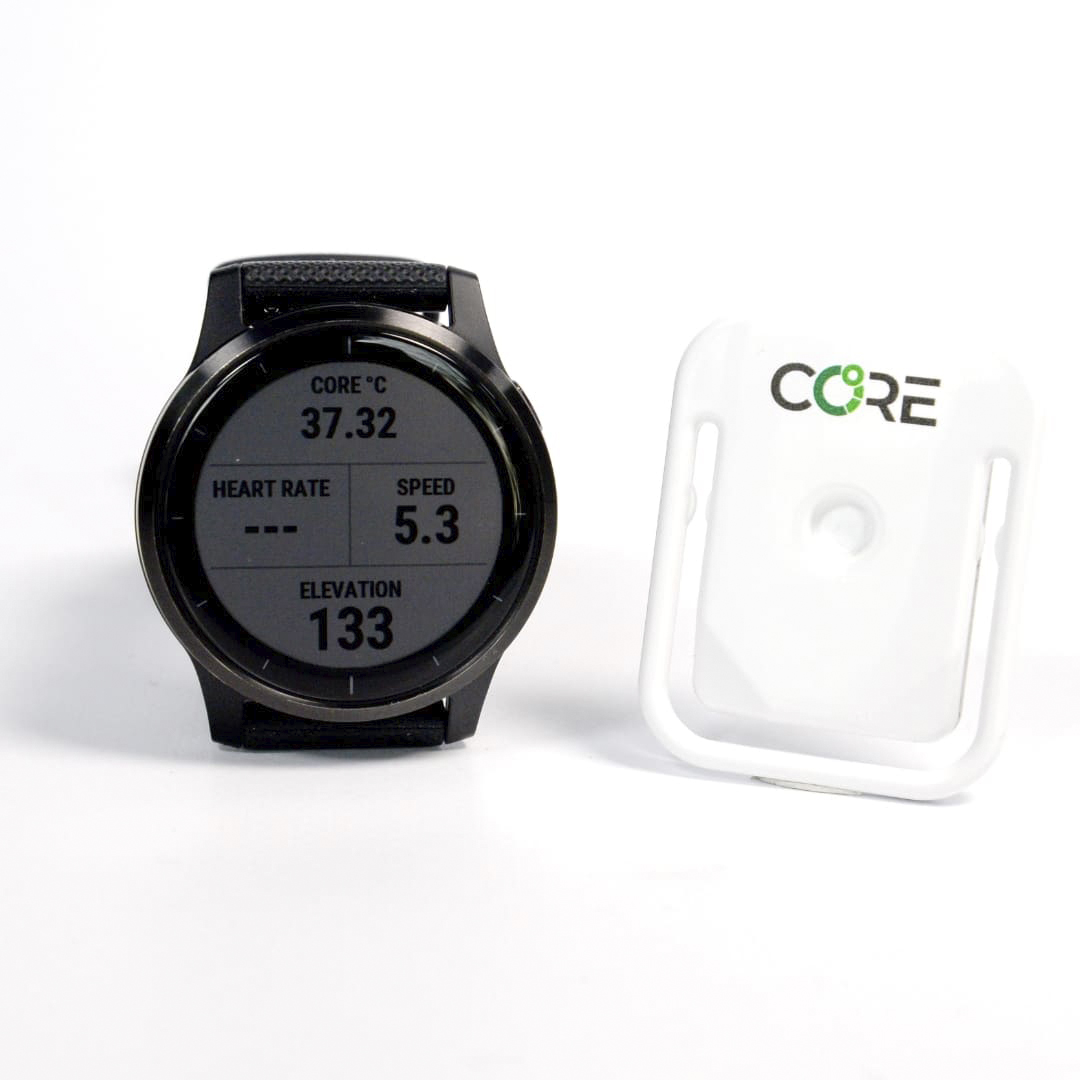CORE 2 thermal sensor
How to facilitate heat training?
Even the slightest overheating can lead to a decrease in performance. It's therefore not surprising that athletes are engaging in heat training. To do this, they of course need to be able to monitor their body temperature. That's where the CORE 2 thermal sensor is for.
Performance decrease due to overheating
Exercice can raise your core temperature to as much as 40°C. That's normal, and your body gets rid of the excess heat by sweating. But when it's particularly hot, this temperature can rise even higher - and that has a negative impact on your performance.
To put it simply: in warmer conditions, blood is redirected toward the skin to release internal heat. As a result, less oxygen reaches your muscles, and they're less able to generate power. That explains the drop in performance: your VO2 max decreases when your body overheats.
Optimizing performance with the CORE 2 body temperature sensor
Avoiding overheating in extreme heat requires training. Heat training. And that brings us to the value of a CORE body temperature sensor. When you know how your body responds and how high your core temperature rises during exercice inthe heat, you can take targeted actions to cool down, stay hydrated and perform efficiently.
The CORE thermal sensor continuously and accurately measures your body temperature. This is especially useful for training within specific heat zones. Through heat training, you help your body adapt to higher internal temperatures, so you're better prepared on race day.
During competition, this data can tell you exactly when to apply cooling strategies, when to hydrate, or when to reduce your pace or power to avoid overheating.
What does the CORE 2 thermal sensor measure?
Heat strain index: this score describes the physiological processes that cool the body. The harder your body works to cool itself, the greater the strain, and the impact on your performances.
Heat adaptation score: this score indicates how well your body is adapted to heat on a scale of 0-100%. The higher the score, the better your body is adapted.
Heat training load: this is the daily value of the amount of time spent in the heat training zone (zone 3), on a scale of 1-10. Optimal heat training involves 2 to 3 sessions per week, with 45 to 60 minutes per session in the heat training zone. Sequential days with high heat training load will increase your heat adaptation score.
Core and skin temperatures: the core body temperature is the temperature near internal organs in the torso. This temperature rises when we exercice. If it rises too high, performance suffers. The skin temperature helps your body regulate the core temperature. Both are used to calculate your heat strain index.
CORE thermal sensor in detail
- Dimensions: 41,9x29,4x7,1mm
- Weight: 11,4g
- Battery life: 6 days in use, up to 30 days with standby mode enabled
- Power supply: USB-C magnetic adapter cable included
- Waterproof up to 1,5m (IPX7)
- Connectivity: Bluetooth BLE & ANT+
- Research-backed accuracy: mean difference range of -0,01°C to +0,23°C
CORE 2 thermal sensor
How to facilitate heat training?
Even the slightest overheating can lead to a decrease in performance. It's therefore not surprising that athletes are engaging in heat training. To do this, they of course need to be able to monitor their body temperature. That's where the CORE 2 thermal sensor is for.
Performance decrease due to overheating
Exercice can raise your core temperature to as much as 40°C. That's normal, and your body gets rid of the excess heat by sweating. But when it's particularly hot, this temperature can rise even higher - and that has a negative impact on your performance.
To put it simply: in warmer conditions, blood is redirected toward the skin to release internal heat. As a result, less oxygen reaches your muscles, and they're less able to generate power. That explains the drop in performance: your VO2 max decreases when your body overheats.
Optimizing performance with the CORE 2 body temperature sensor
Avoiding overheating in extreme heat requires training. Heat training. And that brings us to the value of a CORE body temperature sensor. When you know how your body responds and how high your core temperature rises during exercice inthe heat, you can take targeted actions to cool down, stay hydrated and perform efficiently.
The CORE thermal sensor continuously and accurately measures your body temperature. This is especially useful for training within specific heat zones. Through heat training, you help your body adapt to higher internal temperatures, so you're better prepared on race day.
During competition, this data can tell you exactly when to apply cooling strategies, when to hydrate, or when to reduce your pace or power to avoid overheating.
What does the CORE 2 thermal sensor measure?
Heat strain index: this score describes the physiological processes that cool the body. The harder your body works to cool itself, the greater the strain, and the impact on your performances.
Heat adaptation score: this score indicates how well your body is adapted to heat on a scale of 0-100%. The higher the score, the better your body is adapted.
Heat training load: this is the daily value of the amount of time spent in the heat training zone (zone 3), on a scale of 1-10. Optimal heat training involves 2 tot 3 session per week, with 45 to 60 minutes per session in the heat training zone. Sequential days with high heat training load will increase your heat adaptation score.
Core and skin temperatures: the core body temperature is the temperature near internal organs in the torso. This temperature rises when we exercice. If it rises too high, performance suffers. The skin temperature helps your body regulate the core temperature. Both are used to calculate your heat strain index.
CORE thermal sensor in detail
- Dimensions: 41,9x29,4x7,1mm
- Weight: 11,4g
- Battery life: 6 days in use, up to 30 days with standby mode enabled
- Power supply: USB-C magnetic adapter cable included
- Waterproof up to 1,5m (IPX7)
- Connectivity: Bluetooth BLE & ANT+
- Research-backed accuracy: mean difference range of -0,01°C to +0,23°C




